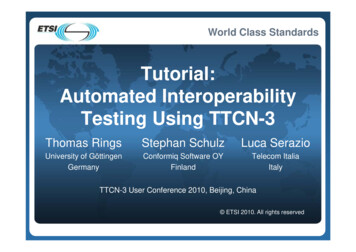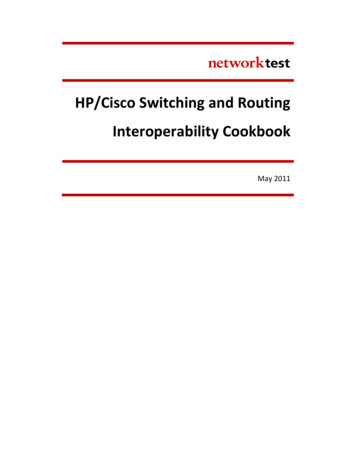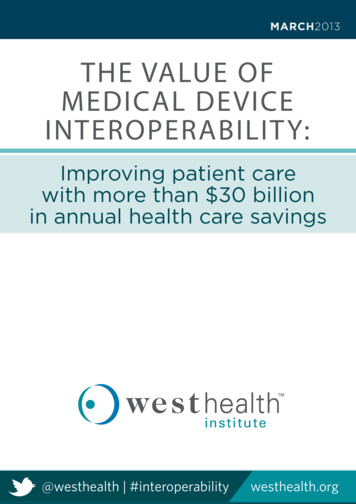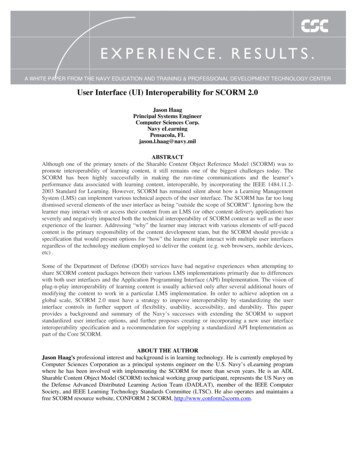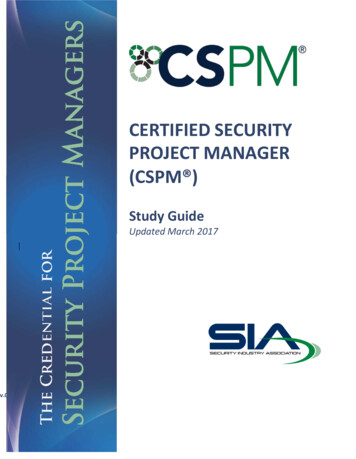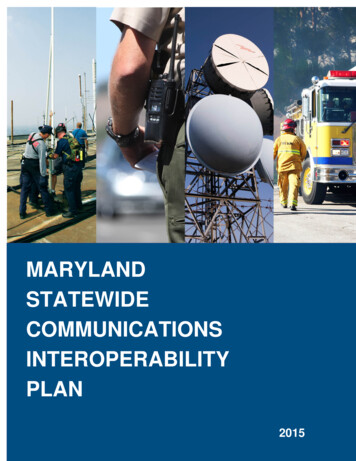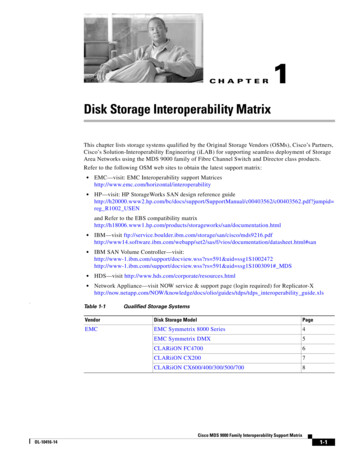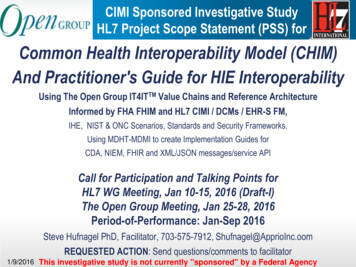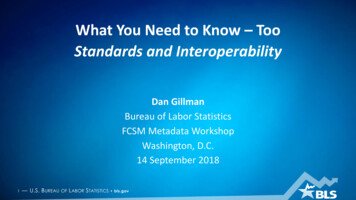
Transcription
What You Need to Know – TooStandards and InteroperabilityDan GillmanBureau of Labor StatisticsFCSM Metadata WorkshopWashington, D.C.14 September 20181— U.S. B UREAUOF L ABORSTATISTICS bls.gov
Outline Standards in GeneralInteroperabilityCase for StandardsData Integration Scenario Discovery Data dictionary Methodology 2Overview of Statistical Metadata Standards— U.S. B UREAUOF L ABORSTATISTICS bls.gov
StandardsMany standards development organizations (SDO) Open standards built by a process that is Consensus-driven Open Transparent Fair Balanced 3general agreement w/o sustained dissentany stakeholder can joinprocess available for inspectioneveryone has same rightsstakeholders represent user communityIncludes ISO, W3C, NISO, DDI Alliance, UNECE— U.S. B UREAUOF L ABORSTATISTICS bls.gov
StandardsCaveat Many SDOs, many standards “Standards are great. There are so many of them!”– Karsten Rasmussen “Standards are useless; look at the second S!”– Adrienne Tannenbaum4— U.S. B UREAUOF L ABORSTATISTICS bls.gov
InteroperabilityInteroperability – ability of one system to work independentlywith some or all of another system Applied often to computerized systems, but also to data Data interoperability – ability to use data from another sourcewithout help from that source Implies extensive metadata are available 5— U.S. B UREAUOF L ABORSTATISTICS bls.gov
InteroperabilityBut, metadata are data, too Data interoperability must include metadata interoperability Does this require the metadata have metadata? Shared metadata model needed Standard Technical specification 6Minus that, data problem is just repeated— U.S. B UREAUOF L ABORSTATISTICS bls.gov
Standards – Why?Reduces or eliminates design steps Increases chances for interoperability Standards neither necessary nor sufficient Building systems – claims of conformity Conformance – Satisfaction of all requirements Systems can be built independently Allows system builders to achieve interoperability7— U.S. B UREAUOF L ABORSTATISTICS bls.gov
Standards – Why? If your metadata system conforms to a specification I can build a system to read your metadata automatically I can write metadata in a format you can understand immediately But, if I use a different specification, then I have to translate your metadata into my specification and vice-versa May not be easy With 13 principal statistical agencies (minus OMB),– Possible translations: (13 choose 2) 78– This is too complex; Need cooperation8— U.S. B UREAUOF L ABORSTATISTICS bls.gov
Standards – Why?Adopting standards greatly reduces this problem There’s still the problem of the second S There may be many standards to choose among Let’s try to make sense of this problem Standards developed to solve certain problems – Scope Don’t use them beyond their scope9— U.S. B UREAUOF L ABORSTATISTICS bls.gov
Standards IllustratedThrough a data integration scenario Illustrate metadata “content” standards Focus on what can be described Not on how to build a systemOverview, not detailed descriptions Include some about the groups developing the standards 10— U.S. B UREAUOFLABOR STATISTICS bls.gov
Scenario “America’s Safest Cities” by Zack O’Malley Greenburg 26 October 2009 Forbes Magazine Rank cities by “livability” Workplace fatalities Traffic fatalities Violent crimes Natural disaster risk11— U.S. B UREAUOFLABOR OafSTATISTICS bls.govEurope2010-11
Scenario Rank MSAs based on Numerical ranking for each measure Sum of rankings Questions Can we find and understand relevant data? If so, where? how?12— U.S. B UREAUOFLABOR OafSTATISTICS bls.govEurope2010-12
Scenario – Discovery Natural to ask if data can easily be found through search Quick answer – No Google searches not entirely successful– URLs provided for relevant web sites– Relevant data sets, no– Still had to search web sites to find data Discovery is a very hard problem Guarantee to find all resources on a particular subject?13— U.S. B UREAUOFLABOR STATISTICS bls.gov
Scenario – Discovery Another solution – data set registry or catalog Think – library card catalog But – on lineLook at Data.Gov Many other catalogs in existence Museums – Smithsonian Museum of Natural History Libraries – Library of Congress14— U.S. B UREAUOFLABOR STATISTICS bls.gov
Discovery (Catalog) Standards Relevant standards Project Open Data Metadata Schema Dublin Core Metadata Initiative MARC – MAchine Readable Catalog ISO/IEC 11179 – Metadata registries DCAT (Data Catalog Vocabulary) DDI (Data Documentation Initiative)15— U.S. B UREAUOFLABOR STATISTICS bls.govData.GovNISO, ISONISO, ISOISOW3CDDI Alliance
Scenario – Discovery Finding data – Discovery Workplace fatalities– Bureau of Labor Statistics16 — U.S. B UREAU OF L ABOR S TATISTICS bls.govOaf Europe Traffic fatalities– National Highway Traffic SafetyAdministration201016
ProblemHow do we know to select particular data sets? Are there others? Need data dictionaries to be sure 17— U.S. B UREAUOFLABOR STATISTICS bls.gov
Scenario – Data Dictionary Finding data – Discovery Workplace fatalities– Bureau of Labor Statistics– Data based on MSA– Data given as number, not rate18 — U.S. B UREAU OF L ABOR S TATISTICS bls.govOaf Europe Traffic fatalities– National Highway Traffic SafetyAdministration– Data based on city, not MSA– Based on rates201018
Scenario – Data DictionaryData Dictionary – for statistical data Contains Variables– or Measures– Code lists or Classifications Questions Maybe some methodology as well Description of variables needed at a minimum19 — U.S. B UREAU OF L ABOR S TATISTICS bls.govOaf Europe201019
Scenario – Data Dictionary Variables, Measures, Classifications – needed for Selecting specific data sets Using selected data setsLevel beyond discovery Most discovery models don’t account for this 20 — U.S. B UREAU OF L ABOR S TATISTICS bls.govOaf Europe201020
Data Dictionary StandardsISO/IEC 11179 DDI Codebook Lifecycle UNECE GSIM (Generic Statistical Information Model) Inter-agency SCOPE/Metadata Data dictionary specification21 — U.S. B UREAU OF L ABOR S TATISTICS bls.govOaf Europe201021
Scenario – Methodology Methodological issues Questions Sampling Post-collection processing Post-collection estimationThese can affect analyses And there are standards to document these 22— U.S. B UREAUOFLABOR STATISTICS bls.gov
Standards for Methodology DDI (Data Documentation Initiative) Codebook LifecycleGSIM (Generic Statistical Information Model) GSBPM (Generic Statistical Business Process Model) 23— U.S. B UREAUOFLABOR STATISTICS bls.gov
SCOPE/Metadata SCOPE - Statistical Community of Practice and Engagement Group to leverage common practice among agencies Reduce costs, Increase sharing Formed inter-agency group on metadata– Produced first data.gov specification– Geared towards statistical data sets– Produced data dictionary specification Variables, Measures, Code Lists, and Classifications SCOPE/Metadata Meets bi-weekly Needs more participants24— U.S. B UREAUOFLABOR STATISTICS bls.gov
ISO/IEC 11179 ndards/index.htmlFirst standard on metadata, model based, reusable metadataOperational needs for a registry or catalogStandard built in 6 partsUsed as input to DDI, GSIM, SDMX, and SCOPE/Metadata SDMX – Statistical Data and Metadata eXchange 25Freely available from ISO— U.S. B UREAUOFLABOR STATISTICS bls.gov
GSIM and GSBPM Developed under UNECE UN Economic Commission for Europe Comprises Europe, Canada, and US Statistical cooperative program is world-wideStatistical metadata standards under Modernization efforts Many countries involved, especially Australia, Canada, New Zealand, US France, Italy, Netherlands, Portugal, Scandinavia, Slovenia26— U.S. B UREAUOFLABOR STATISTICS bls.gov
ic Statistical Information Model Model of statistical information objects 4 main sections– Conceptual, Structural, Business, Exchange High level, conceptual model No bindings – not directly implementable Some effort to build implementable system (LIM)27— U.S. B UREAUOFLABOR STATISTICS bls.gov
eric Statistical Business Process Model Outline of statistical life-cycle processes Eight main phases Each phase has subparts Adopted by agencies to classify IT efforts and systems 28— U.S. B UREAUOFLABOR STATISTICS bls.gov
DDIDDI Alliance - https://www.ddialliance.org/Consortium of data libraries, archives, producers, researchers Two threads Codebook – data dictionary, not reusable metadata Lifecycle – GSBPM-based– reusable, extensive methodology, includes Codebook– GSIM profile 29Both bound to XML, so immediately implementableUniversity and commercial software availableYearly user conferences: NADDI, EDDI— U.S. B UREAUOFLABOR STATISTICS bls.gov
SDMX https://sdmx.org/Managed by BIS, ECB, Eurostat, IMF, OECD, UNSD, WBFor exchange of dimensional data N-cubes, time series, other 30Based on XML, so implementableComplex learning curveExtensive installed baseYearly user conferences— U.S. B UREAUOFLABOR STATISTICS bls.gov
Questions31— U.S. B UREAUOFLABOR STATISTICS bls.gov
Contact InformationDan Gillman(202) 691-7523Gillman.Daniel@bls.gov32— U.S. B UREAUOFLABOR STATISTICS bls.gov
8 —U.S. BUREAUOFLABORSTATISTICS bls.gov Standards -Why? If your metadata system conforms to a specification I can build a system to read your metadata automatically I can write metadata in a format you can understand immediately But, if I use a different specification, then I have to translate your metadata into my specification and vice-versa
